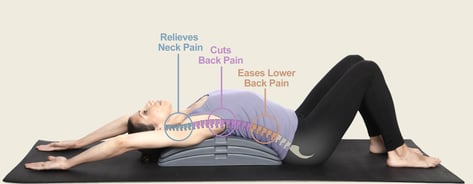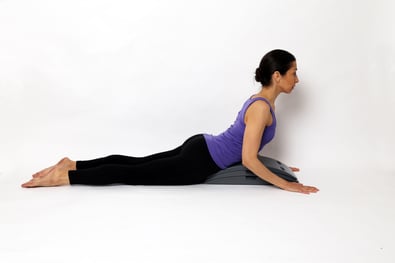Tech/Text Neck
 Are on you on a computer or mobile device right now? Posture check - What is your posture? Is your neck craned forward, are you looking down, are your shoulders hunched forward? Welcome to the 21st century problem called tech neck (or “text neck”). People are spending more time sitting at computers and scrolling on smartphones, and the way you tilt your head and hunch over your screen is wreaking havoc on your neck and back. Sitting behind a computer for hours a day will cause muscle imbalances (Upper Crossed Syndrome) and forward head posture that causes neck and back pain.
Are on you on a computer or mobile device right now? Posture check - What is your posture? Is your neck craned forward, are you looking down, are your shoulders hunched forward? Welcome to the 21st century problem called tech neck (or “text neck”). People are spending more time sitting at computers and scrolling on smartphones, and the way you tilt your head and hunch over your screen is wreaking havoc on your neck and back. Sitting behind a computer for hours a day will cause muscle imbalances (Upper Crossed Syndrome) and forward head posture that causes neck and back pain.
Tech neck is a term commonly used for a repetitive stress injury where excessive phone and computer use is causing neck and back pain. Why? The weight of the human head is 10 to 12 pounds, and when it is flexed forward, that’s leveraged to 50+ pounds of pressure. Our necks are not capable of handling this excess pressure for long periods of time. Improper posture when using technology is not only causing that hunch in our back but also it is causing a lot of unnecessary back and neck pain.
Signs of Tech Neck
Tech neck symptoms commonly include one or more of the following:
- Pain in the neck, upper back, and/or shoulder - This pain may be located in one specific spot and you may feel intense or stabbing, or it may be a general ache and soreness that covers a broader region, such as spanning from the bottom of the neck and into the shoulder(s).
- Forward head posture and rounded shoulders - The neck and back can become imbalanced due to prolonged forward head posture, and this makes it difficult for you to maintain good posture with the ears directly over the shoulders. Your bad posture overextends the shoulders, making them stiff and sore. When you round your shoulders, you hinder your body’s ability to take deep breaths, and your oxygen levels can drop too!
- Reduced mobility - The neck, upper back, and shoulders may all experience some tightness and reduced mobility.
- Headache - Excessive amounts of time looking at screens, regardless of posture, may also increase the risk for eyestrain and headache.
- Increased pain with neck flexion - Tech neck symptoms tend to worsen when the neck is flexed forward into the position that originally caused the problem, such as while looking down and texting. Also, muscles at the base of the neck may frequently spasm.
- Balance issues - Prolonged amounts of time in forward head posture have been linked to reduced balance control due to the head’s center of gravity migrating further to the front of the body. This movement can result in muscle imbalances and postural control changes in the neck and torso.
- Jaw (TMJ) pain - A misalignment in the cervical spine and/or muscle imbalances may lead to jaw pain, or temporomandibular joint (TMJ) pain.
- Cervical radiculopathy - Cervical radiculopathy can occur when a cervical nerve root becomes irritated or compressed, such as from spinal changes related to degenerative disc disease or osteoarthritis. Severe cases of tech neck may accelerate or worsen this process. This is either an electric shock-like pain, pins-and-needles tingling, numbness, and/or weakness that may radiate from the neck down into the shoulder, arm, and/or hand.
Tips For Preventing and Correcting "Tech Neck”
Using proper posture when you interact with technology will go a long way in eliminating your pain. And, there are exercises you can do to stretch tight muscles to reverse neck and back pain. Listed below are a few tips:
Proper Posture When Using Technology
- Hold your phone just below eye-level. Use your index finger to text, and not your thumbs.
- When using technology, sit up straight with your head in a neutral position (ears over your shoulders) with good posture, and your feet planted flat on the ground. Do not cross your legs!
- Stand up every 20 minutes, take a stroll, and roll your shoulders back.
- Make sure your computer screen is aligned with the middle of your body, and it is at eye level while sitting upright.
Exercises to Reverse Tech Neck and Improve Posture
You can reverse the curvature of your upper back and straighten your neck to reduce the pain you are feeling from hunching forward. Listed below are easy exercises:
- Neck extension - As you stand, focus your eyes on the wall in front of you. Tuck your chin in toward the rear of your body. Hold for 10 seconds and repeat five times. Do this twice a day.
- The Backbridge Extension -
- Get your Backbridge, choose the proper level (level 1 is the easiest and level 5 offers the largest stretch).
- Lie back so that the highest point of the Backbridge is between your shoulder blades and your head touches the floor.
- Rest your arms on the floor over your head and hold this stretch for 2 minutes (repeat twice a day, in the morning and evening).
- After a few weeks, slowly progress to the next level (2-5).

- Upright Chest Lift - Standing or sitting and with your eyes forward, place one hand on top of the other and then place both hands on the back of your head. Gently press your head back into your hands and slightly bend back your upper torso. Hold for 30 seconds. Tilt your pelvis instead of moving your upper-middle back.
- Cobra - Lying face down over the Backbridge, place your hands in front of you and do half a push-up so that your upper torso is elevated but your pelvis still has contact with the Backbridge. Raise your eyes to the ceiling and hold for a count of five, and then slowly lower yourself down and repeat. This stretch really works your lumbar extenders and lower back, while stretching and lengthening the core.

- Floor Cobra with External Rotation –
- Begin by lying face down on the floor with your legs extended behind you. Keep your legs down and position your hands directly under your shoulders.
- Keep your chin tucked, looking down on the floor, then slowly take your hands off the ground and squeeze your shoulder blades together.
- Lower your upper body while staying in that position, and then raise up and contract your glutes.
- Do this motion 10 times.
An individual’s use of mobile devices and computers is not going away. As the old saying goes, “An ounce of prevention is worth a pound of treatment.” Thus, it’s important to follow the tips above to use technology appropriately. By incorporating these exercises, it can help you reverse the curvature of your upper back and straighten your neck to reduce the pain you feel from hunching forward and tech neck.

